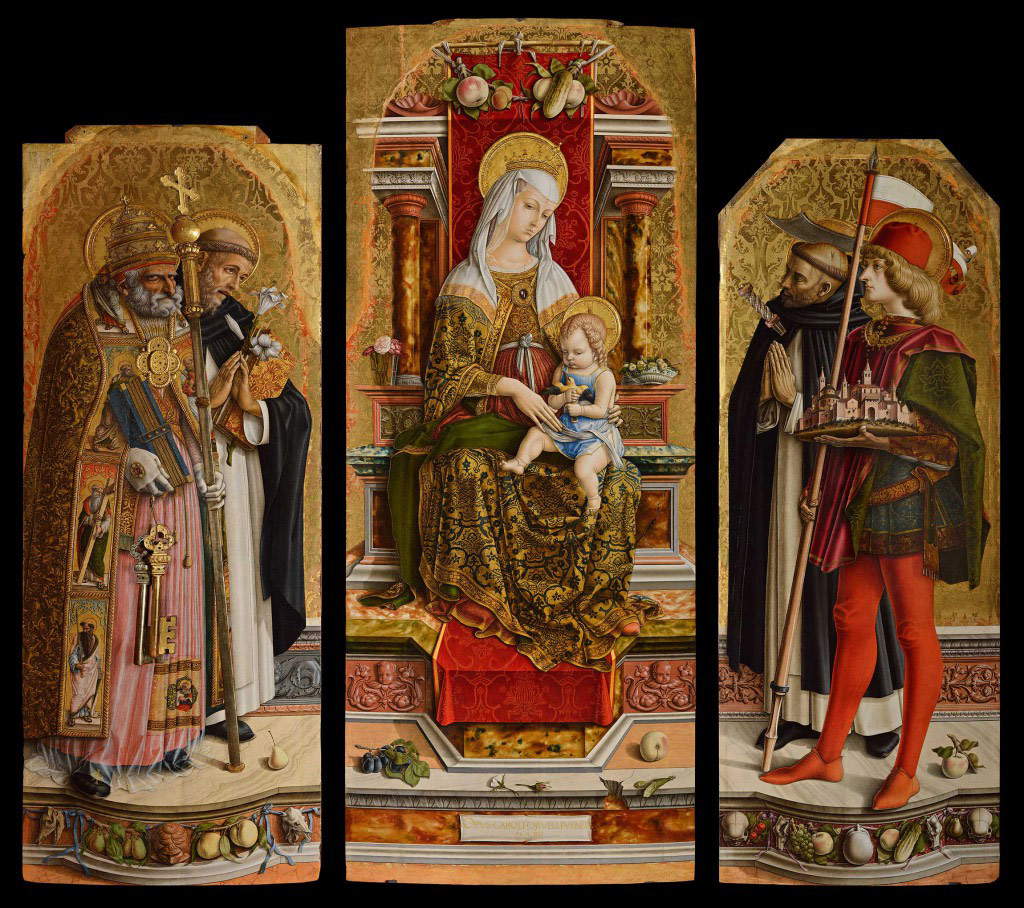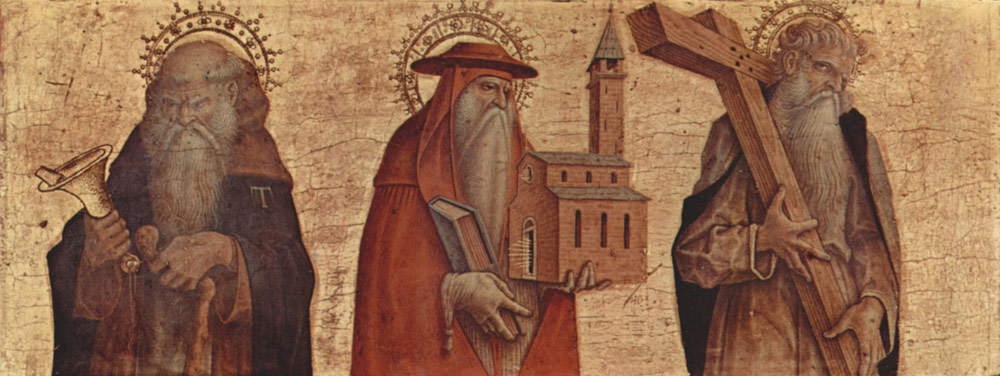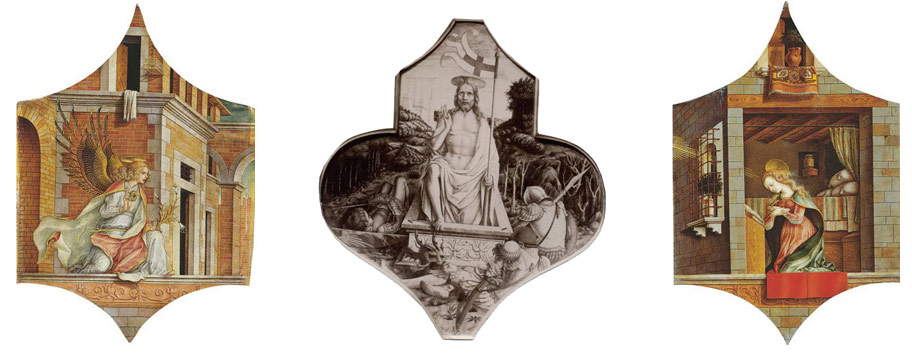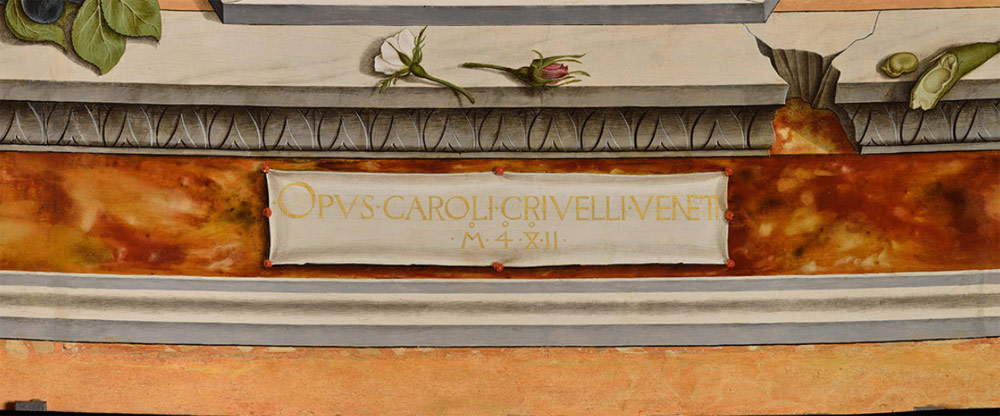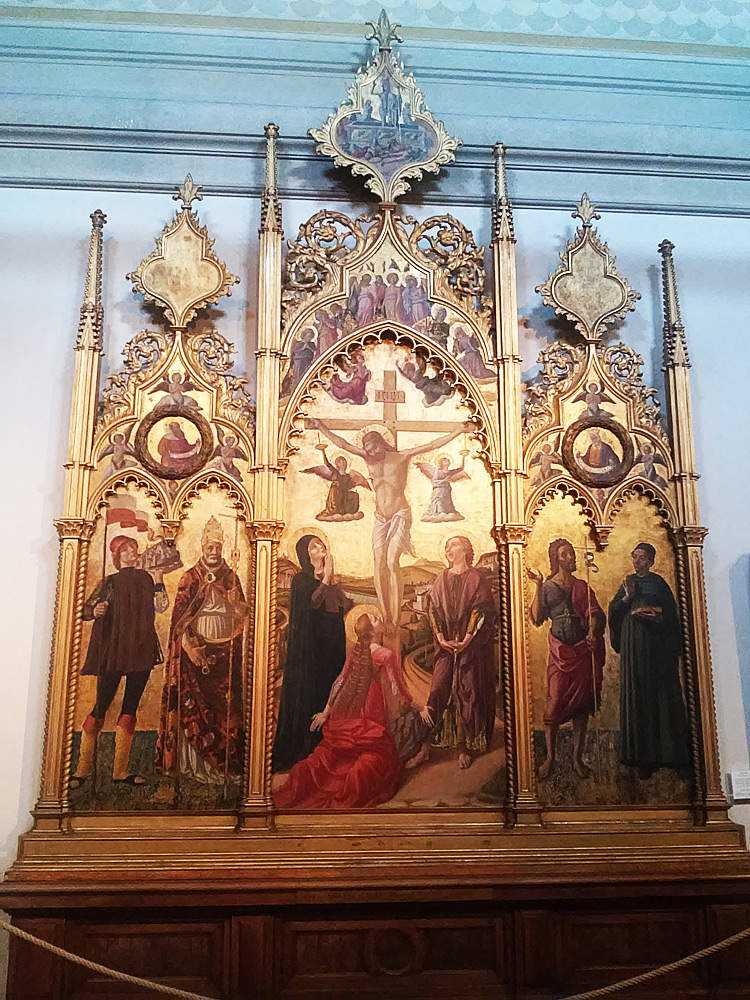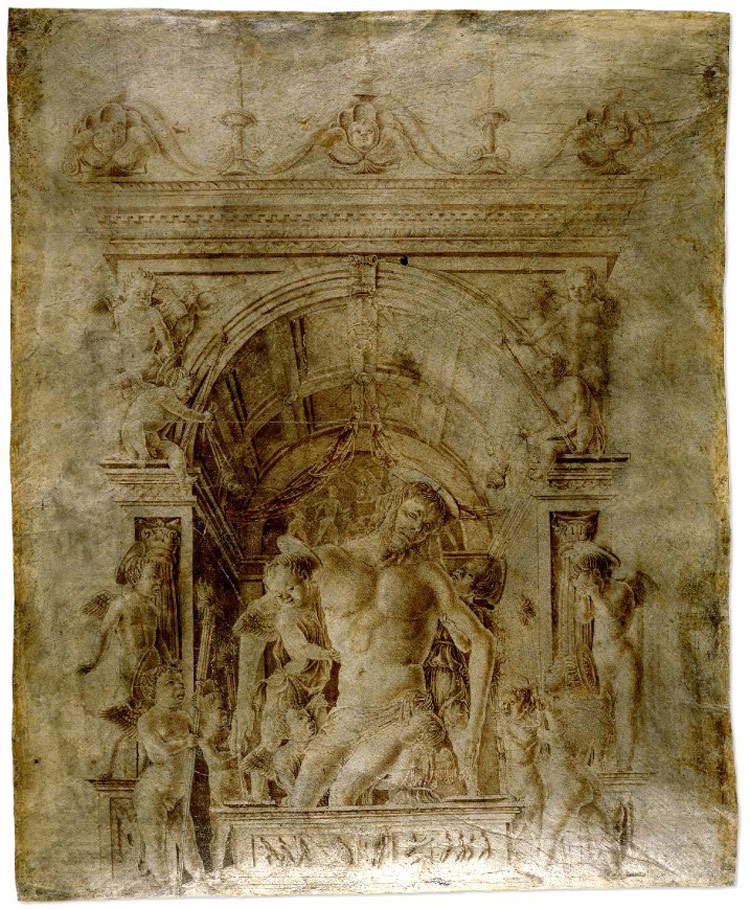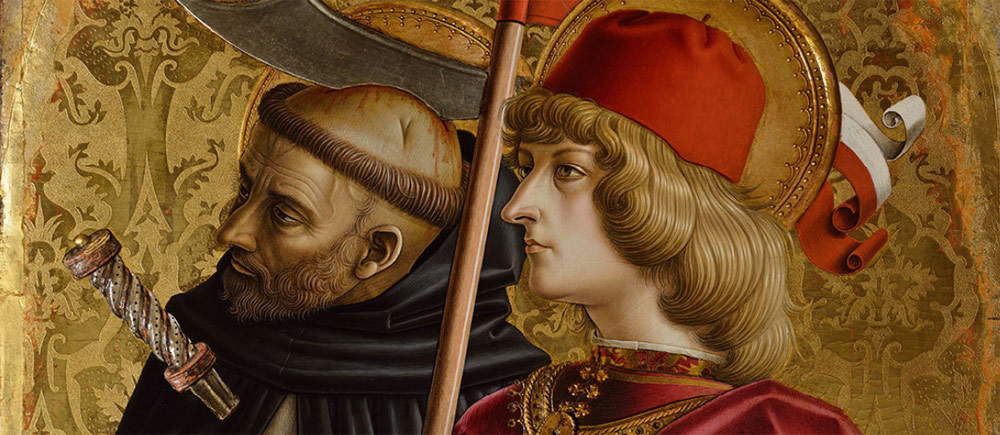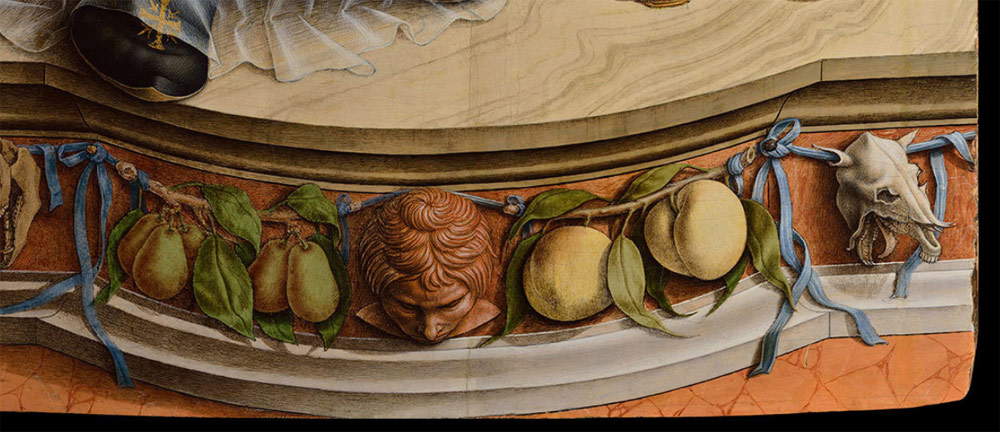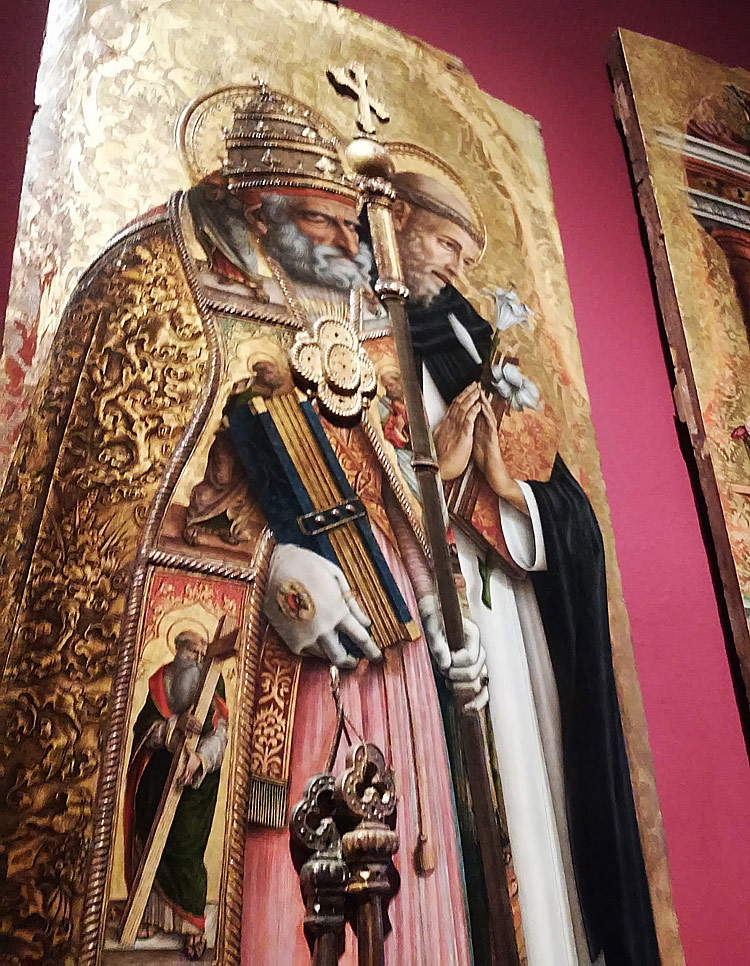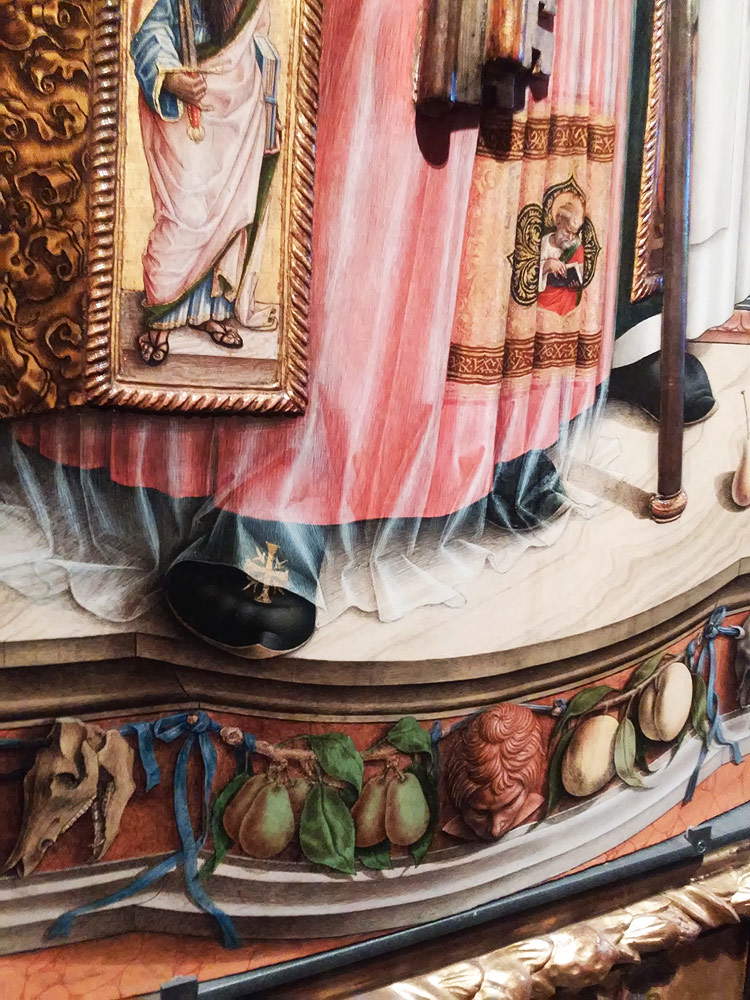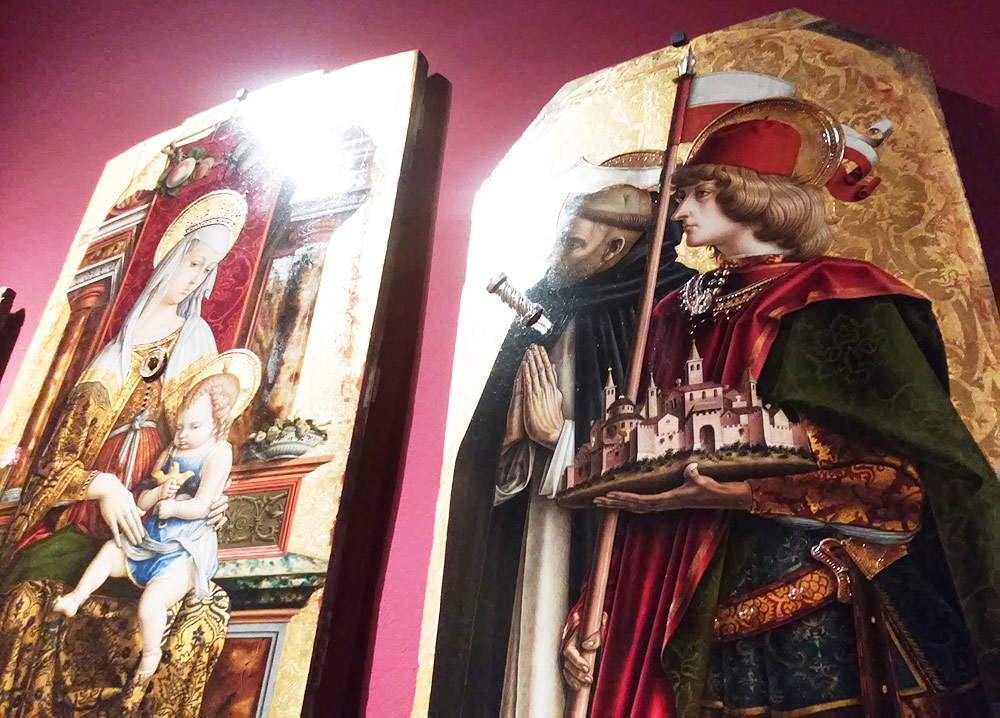by Federico Giannini, Ilaria Baratta , published on 22/06/2018
Categories: Works and artists
- Quaderni di viaggio / Disclaimer
One of the Brera Art Gallery's most fascinating masterpieces is the triptych of San Domenico, a ... three-dimensional work by Carlo Crivelli, created in 1482.
On September 24, 1811, a load of paintings that had been gathered in Ancona and then sent, together, to Milan arrived at the Pinacoteca di Brera: these were the works that Napoleon’s soldiers had requisitioned throughout the Marche region, and among them was a nucleus of works from the convent of San Domenico in Camerino. The most interesting of the works that were inside the Camerino house of worship is the so-called Triptych of San Domenico, made by Carlo Crivelli (Venice?, c. 1430 - Ascoli Piceno, 1495) in 1482: the signature that the artist affixed to the central compartment (where we read “OPVS CAROLI CRVELLI VENETI M48II,” “Work by Carlo Crivelli veneto, 1482”) has handed down to us with certainty the author’s name and date of execution. For a long time it was thought that Crivelli had executed the triptych for the Cathedral of Camerino: the misunderstanding arose because in 1799, following a disastrous earthquake that struck the city and destroyed its cathedral, several works by Crivelli were sheltered in the convent of San Domenico, which had not suffered significant damage, and it was thought that among the works rescued was the large triptych. However, only one large polyptych appears in the inventories of the Duomo, the one made after 1490 and now divided among several museums (the central panel, the so-called Madonna della candeletta, is also in Brera). And again, the presence in the triptych of St. Dominic of two Dominican saints would have been by itself sufficient evidence to support the hypothesis of its presence ab origine in the church from which it was removed. The discovery, made known in 2002, of a document dated 1483 in which the name of the commissioner (a certain Romano di Cola) was attested, and in which it was specified that the polyptych was in St. Dominic’s, helped to dispel any doubts. In addition, the date 1482 makes the Triptych of San Domenico the first work executed by Carlo Crivelli in Camerino, at the time ruled by the Varanos: a detail of no small importance for the understanding of the painting, and more on this below.
When the work arrived at Brera, along with the twelve others by Carlo Crivelli destined for the Milanese institute, every single piece of it was inventoried, a sign that it too was dismembered, probably to facilitate its transport. The fate that befell the San Domenico Triptych, however, was better than that reserved for the Duomo Polyptych, since today all three compartments, together with two panels of the predella, are preserved in a single institute: the three cusps, on the other hand, are divided between the Städel Museum in Frankfurt and the Abegg-Stockar collection in Zurich, while there is no news of the central panel of the predella, although with the recent 2009 exhibition on Carlo Crivelli, held precisely at the Pinacoteca di Brera, it was proposed to identify in theLast Supper now preserved at the Museum of Fine Arts in Montréal, Canada, the missing piece in the reconstruction of the polyptych. It is a work that follows a traditional scheme: in the central compartment, we find the Madonna and Child, seated on a high throne. In the side panels, there are St. Peter and St. Dominic on the left and St. Peter the Martyr and St. Venantius on the right. In the two compartments of the predella we note on the left Saints Anthony Abbot, Jerome and Andrew, while on the right we see James the Elder, Bernardine of Siena and, probably, Blessed Ugolino Malagotti da Fiegni, identified, however, in doubt. In the cusps, a Resurrection in the center separates the figures of the Announcing Angel on the left and the Virgin Announced on the right.
 |
| Carlo Crivelli, Triptych of San Domenico (1482; tempera, gold and pastille inserts on panel, central panel 190.5 x 78 cm, left panel 167 x 63 cm, right panel 167 x 61.8 cm; Milan, Pinacoteca di Brera) |
 |
| Carlo Crivelli, left compartment of the predella of the Triptych of St. Dominic with Saints Anthony Abbot, Jerome and Andrew (1482; tempera and gold on panel, 26 x 62 cm; Milan, Pinacoteca di Brera) |
 |
| Carlo Crivelli, right compartment of the predella of the Triptych of St. Dominic with Saints James and Bernardine of Siena and Blessed Ugolino Malagotti da Fiegni (1482; tempera and gold on panel, 26 x 62 cm; Milan, Pinacoteca di Brera) |
 |
| Carlo Crivelli, Last Supper, probable central compartment of the predella of the Triptych of San Domenico (1482; tempera and gold on panel, 26 x 62 cm; Montréal, Musée des Beaux-Arts) |
 |
| Carlo Crivelli, cymatium of the Triptych of St. Dominic with the Archangel Gabriel, the Resurrection and the Virgin Announced (1482; all tempera on panel, 60.3 x 45.2 cm; Archangel and Virgin in Frankfurt, Städel Museum; Resurrection in Zurich, Abegg-Stockar Collection) |
 |
| The signature on the Triptych of St. Dominic |
The very unusual, but nonetheless not innovative, form of Carlo Crivelli’s polyptych has suggested a reference to a very specific work made by an artist active in Camerino in the same years, Niccolò di Liberatore known as the Pupil (Foligno, c. 1430 - 1502): the Umbrian painter had made, in 1480, a polyptych for the church of San Venanzio, now preserved in the Pinacoteca Vaticana, slender and equipped with a structure in three compartments, with predella (now unfortunately separated from the rest of the polyptych) and cusps enclosed in a flamboyant frame, with mixtilinear arches, of great scenic impact and capable of making use of unusual and peculiar forms, such as those of the cusps, which are slavishly taken up by Carlo Crivelli for the Triptych of San Domenico. The similarities, however, end there: conceptually, the Triptych of St. Dominic is a much more up-to-date work than the one created two years earlier by Niccolò di Liberatore, and it stands as an innovative work even within the path of Carlo Crivelli himself. The main figures, the saints and the Madonna and Child in the center, are all placed in the same space, foreshortened prospectively (albeit empirically) and according to a unified vision (at least apparent, since the decorations differ slightly), with the large stepped structure, decorated with the marbled panels and reliefs of fruit and vegetables typical of the artist, continuing in all three compartments without a break. Also new is the arrangement of the saints in the individual compartments: for the first time they are placed on staggered planes, diagonally, to give a greater impression of three-dimensionality.
Yet, one need not find in the rendering of space the points of greatest interest in the triptych of St. Dominic. Not least because, from this point of view, Crivelli came rather late to appropriate a typically Renaissance spatiality, especially if one keeps in mind the results that contemporary Florentine painting had already achieved. It is easy to get caught up in the mixture of this new conception of space, close to the typical feeling of the 15th century, and the archaizing elements: the exuberant decorativism, the preciousness of the fabrics (observe, by way of example, the Madonna’s very fine robe, the fine damask of the sleeves that sprout under Saint Venantius’ cloak, the sumptuous vestments of Saint Peter, and the elegance of the faux brocade of the gold background of all three compartments), the still courtly atmosphere that permeates the entire composition. “It is precisely the analysis of the painter’s use of decoration,” the scholar Emanuela Daffra wrote in 2002, that “enlightens us as to how Crivelli’s juxtaposition ”to more strictly Renaissance issues should be understood.“ In the decoration, the scholar continued, ”variety and asymmetry prevail (not even the background brocade is identical in the three panels), to illustrate the combinatorial possibilities of an inexhaustible repertoire rather than to compose correct decorations in the antique style. The frieze used horizontally in the parapet behind Saints Venantius and Peter Martyr, the improbable palmettes and embrici in the lintel cornices, the little heads of putti that are real portraits in imitation stone, the ’living’ heads in iscorcio next to skulls and bucrani (i.e., bovine skulls) arise from classical motifs bent in different senses and weave an ambiguous play of reality and fiction much closer to certain artifices of Flemish painting than to the Pierfrancesque Renaissance."
The figurative repertoire of the decorations, Emanuela Daffra always suggested, was clearly Squarcionesque in origin: there are many scholars who believe that Crivelli looked to the Paduan figurative culture of Francesco Squarcione (Padua, 1397 - 1468) and the artists close to him. In particular, the “mediator” in the triptych of San Domenico seems to be Marco Zoppo (Cento, 1433 - Venice, 1478), a direct pupil of Squarcione, who in a drawing in the British Museum, depicting a dead Christ supported by angels, exhibits the same repertoire of putti heads, bucrania, and classical motifs. However, other figurative sources had intervened to mitigate Squarcion’s lively and harsh expressionism. We have already mentioned the debts to Niccolo di Liberatore in terms of structure, but the figure of Saint Venantius could also be analyzed: he is the patron saint of Camerino, and according to tradition he was a Roman nobleman who was born a pagan and converted to Christianity, and was martyred for this. He was a native of Camerino, and in iconography he always carries the banner with the colors of the city on it: thus, and likewise holding a model of the city to present to the Virgin, he is also depicted in the triptych of St. Dominic, which echoes almost exactly the St. Venantius that, ten years earlier, the Camerino painter Girolamo di Giovanni (news from 1449 to 1503) had painted in a large fresco in the church of Sant’Agostino, also in the Marche town. And if the sweetness of the features of the Virgin’s face suggests Umbrian suggestions, the great attention to detail calls Flemish references instead.
 |
| Niccolò di Liberatore known as the Pupil, Polyptych of San Venanzio (1480; tempera and gold on panel; Vatican City, Vatican Pinacoteca) |
 |
| Marco Zoppo, Dead Christ Supported by Angels (c. 1455-1457; pen and ink on parchment; London, British Museum) |
 |
| Girolamo di Giovanni, Madonna and Saints (c. 1470-1480; fresco, 214 x 365 cm; Camerino, Pinacoteca and Museo Civico) |
 |
| Carlo Crivelli, Triptych of San Domenico, the figure of the Madonna |
 |
| Carlo Crivelli, Triptych of St. Dominic, St. Peter and St. Dominic |
 |
| Carlo Crivelli, Triptych of St. Dominic, St. Peter the Martyr and St. Venantius |
 |
| Carlo Crivelli, Triptych of St. Dominic, the base of the throne |
 |
| Carlo Crivelli, Triptych of St. Dominic, the model of the city of Camerino |
That Carlo Crivelli intended to flaunt his typically coruscating and glittering stylistic signature is also evident from the relief inserts that the artist inserted into the painting to make the three-dimensionality of the work become real. Evidently the great illusionism, which we notice from details such as St. Peter’s foot placed on the step with the toe of the shoe sticking out, or such as the same convex step, with its pears, apples, and cucumbers that seem to spill out of the physical space of the work, was not enough for him: Crivelli needed something that really spilled out of the painting. And so here are the extraordinary inserts: St. Peter’s keys, his crosier, the jewels of St. Venantius and the Virgin, the knife that, as per typical iconography, sinks into the skull of St. Peter the martyr, and again the handle of the one that pierces his chest are elements that still hark back to a late Gothic taste but that captivate the visitor who happens to pass by room XXII of the Brera Art Gallery, since looking at the triptych we do not see a pair of painted keys, but we see real keys, made according to artisanal techniques and thus applied to the two-dimensional work.
The Venetian artist, for his inserts, used the technique of pastille relief, which flourished in the International Gothic period: astucco application was added to the panel, modeled with the shapes of the object, decoration or figure that one wanted to obtain, and then it was covered with gold leaf, or it was colored. The result was impressive and, in an artistic environment such as Camerino, was still to meet with the favor of patrons and the public. Alessandra Fregolent writes that “in the polyptych executed for the church of San Domenico di Camerino (Milan, Brera), dated 1482, we almost encounter evidence of ’material realism’ in the blade piercing the head of St. Peter the martyr, obtained with the inclusion of metal leaf, or in the truly three-dimensional keys in the hand of St. Peter. To the profusion of precious metals and elaborate decorative effects we owe much in the fascination, the one most immediately perceptible, of Crivelli’s polyptychs, which in this respect recall the refined painting of the international Gothic period, particularly Gentile da Fabriano, importer in Venice of devices that by making the pictorial material even more precious achieve results of great optical suggestion.”
 |
| Carlo Crivelli, Triptych of St. Dominic, Keys of St. Peter |
 |
| Carlo Crivelli, Triptych of St. Dominic, the objects of St. Peter |
 |
| Carlo Crivelli, Triptych of St. Dominic, detail of the foot of St. Peter |
 |
| Carlo Crivelli, Triptych of St. Dominic, details of St. Venantius and St. Peter the Martyr |
At the time, in the late fifteenth century, the Varano seigniory rivaled that of the Montefeltros in nearby Urbino: art, too, was a means of affirming the prestige of the seigniory, and greater refinement, a more exalted display of sumptuousness, an exhibited luxury could serve the purpose. Carlo Crivelli was one of the greatest interpreters of this fruitful and intense season of Camerte art. An interpreter who nevertheless did not renounce thehumanity of his characters in the name of magnificence. As contrived as his art was, as fundamentally divorced from the Renaissance revolution that was taking place in other parts of Italy, so much so that critics were divided between those who considered Carlo Crivelli a mere latecomer and those who considered him an artist who was aware of the innovations of the Renaissance but tied to its dreamy late Gothic atmospheres, he nevertheless succeeded in infusing his protagonists with feeling. Artifice, in the triptych of St. Dominic, does not affect the emotions of the saints nor their humanity: the wrinkled and almost grotesque expression of St. Peter with the wrinkles marking his face, the dense expression of mysticism of St. Dominic, the sober concentration of St. Peter Martyr and St. Venantius, with the former more melancholy and the latter more proud, reveal a careful study of emotions that infuses this marvelous polyptych with great strength.
Lionello Venturi had also noted this: in his work The Origins of Venetian Painting, published in 1907, the great art historian identified in the triptych of San Domenico not only the apex of Crivellesco’s decorativism, but also the pinnacle of his investigation of feelings. “In ’82,” wrote Venturi, “while bringing to perfection his decorative ideal, the very rich sumptuous thrones, with the particular motifs of the fruit, the breaking up of the marbles and the like, Crivelli arrives at the more serious expression of the group, more psychologically right. The tendency noted from the early years in the sadness of the faces, hieratic, noble, finds in this time the greatest manifestation. And proof of this is also the successful attempt in the Brera triptych, where the de facto division between the various compartments of the painting so that the side saints each live on their own is eliminated, and instead paired participate in the sacred scene.” It is a work where the emotional tension is such that “for attention all the figures stretch their necks out of their very rich vestments.” Wealth and humanity, decorativism and refinement in a work by an independent artist who is difficult to pin down, but who was able to give us works capable of capturing us with his unquestionable charm and transporting us into his unique golden world, characterized by that elegance, creativity, imagination and cultured awareness that manage to make him elude any clear definition.
Reference bibliography
- Emanuela Daffra (ed.), Crivelli a Brera, exhibition catalog (Milan, Pinacoteca di Brera, from November 26, 2009 to March 28, 2010), Electa, 2009
Andrea De Marchi- , La pala d’altare: dal paliotto al polittico gotico, Art & Libri, 2009
- Andrea De Marchi, Pittori a Camerino nel Quattrocento Federico Motta Editore, 2002
- Marina Massa (ed.), Il patrimonio disperso:
- the exemplary “case” of Carlo Crivelli, proceedings of the conference (Montefiore dell’Aso, Oct. 12, 1996; Camerino, Oct. 26, 1996; Porto San Giorgio, Nov. 9, 1996), Maroni Editore, 1999
- Stefano Papetti (ed.), Vittore Crivelli and the painting of his time in the Fermano area, 24 Ore Cultura, 1997
- Alessandra Fregolent, Matter and Image in Carlo Crivelli, in Arte, 10 (1996), pp.29-33
- Giuseppe Vitalini Sacconi, Pittura marchigiana: La scuola camerinese, Cassa di Risparmio della Provincia di Macerata, 1968
- Lionello Venturi, Le origini della pittura veneziana, Istituto Veneto di Arti Grafiche, 1907
Warning: the translation into English of the original Italian article was created using automatic tools.
We undertake to review all articles, but we do not guarantee the total absence of inaccuracies in the translation due to the program. You can
find the original by clicking on the ITA button. If you find any mistake,please contact us.
